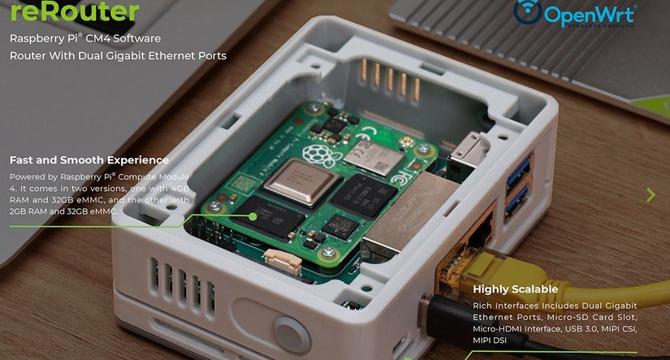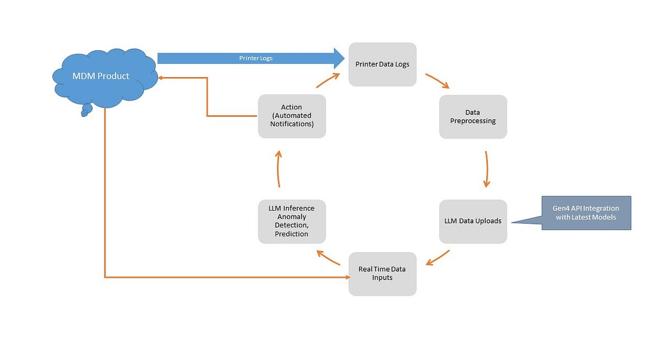IOT News
Iotbyhvm
438

Image Credit: Iotbyhvm
reRouter CM4 1432: Compact Powerful Networking Solution
- The reRouter CM4 1432 by Seeed Studio is a purpose-built mini router designed for compact, reliable, and high-performance soft routing applications.
- Key features include dual Gigabit Ethernet ports, integration of Raspberry Pi CM4, a custom OpenWRT system, and dual USB 3.0 ports.
- The compact device is suitable for home, office, and travel use, and is ideal for creating firewalls, VPN servers, or as an edge router.
- With a durable and portable design, the reRouter CM4 1432 offers powerful performance in a compact form factor, making it a versatile solution.
Read Full Article
26 Likes
Iotbyhvm
196

Image Credit: Iotbyhvm
Dual GbE Carrier Board with 4GB RAM and 32GB eMMC
- The Dual GbE Carrier Board with 4GB RAM and 32GB eMMC is a powerful expansion for the Raspberry Pi Compute Module 4 (CM4).
- This guide provides instructions for setting up the board as a network router or an edge computing unit, utilizing the dual Gigabit Ethernet ports.
- For setting up a network router, the hardware setup involves inserting the CM4 into the Dual GbE Carrier Board, connecting the power adapter and Ethernet cables, and powering on the device. OpenWRT is then installed for router functionality, followed by enhancing router performance with NAT acceleration, AdGuard Home for ad blocking, and configuring VPN using WireGuard.
- For setting up an edge computing unit, the process involves installing dependencies such as Docker and AI libraries, and deploying edge AI applications for real-time analytics and data streaming.
Read Full Article
11 Likes
Iotbyhvm
269

Image Credit: Iotbyhvm
PCIe 3.0 to Dual M.2 HAT for Raspberry Pi 5
- The PCIe 3.0 to Dual M.2 HAT by Seeed Studio enhances the functionality of the Raspberry Pi 5 by supporting dual M.2 NVMe SSDs.
- The HAT provides high-speed storage expansion using PCIe-based peripheral connectivity, making it ideal for server applications, edge computing, AI workloads, personal cloud, and high-performance computing.
- The compact and efficient design of the board maintain optimal space management while keeping the Raspberry Pi 5 lightweight.
- Setting up the PCIe 3.0 to Dual M.2 HAT involves aligning and connecting the HAT to the PCIe connector on the Raspberry Pi 5 and securing the NVMe SSDs using the provided mounting screws.
- The board supports up to PCIe 3.0 speeds for faster data transfer, ensuring improved read-write speeds for data-intensive applications.
- The HAT is easy to install with the secure PCIe connection, making it an ideal plug-and-play expansion board for Raspberry Pi 5 enthusiasts.
- Users can improve the longevity of their SSDs and optimize performance by enabling TRIM and adjusting I/O scheduler.
- The PCIe 3.0 to Dual M.2 HAT is an essential upgrade for Raspberry Pi 5 users who want high-speed storage expansion, making it ideal for power users and those working with edge computing, AI, NAS, and high-performance computing applications.
- The board supports dual M.2 NVMe SSDs and a plug-and-play design, making it easy to set up and use for users with varying levels of technical expertise.
- Whether you're setting up a NAS, AI workstation, media center, or a high-performance computing system, the PCIe 3.0 to Dual M.2 HAT ensures fast, reliable, and scalable storage solutions.
Read Full Article
16 Likes
Iotbyhvm
292

Image Credit: Iotbyhvm
reComputer AI R2130-12 by Seeed Studio: A Comprehensive Guide
- The reComputer AI R2130-12 by Seeed Studio is a high-performance AI computing platform powered by the NVIDIA Jetson Orin NX 16GB module.
- It offers robust AI inference capabilities and is suitable for edge AI, robotics, smart vision, and industrial applications.
- Key features include high-performance AI computing, multiple I/O interfaces for expandability, optimized for edge AI and industrial applications, preloaded with NVIDIA JetPack SDK, and efficient power management.
- The reComputer AI R2130-12 is suitable for AI-powered robotics, smart video analytics, industrial automation, autonomous vehicles & drones, healthcare AI, and retail & smart city applications.
Read Full Article
17 Likes
Discover more
Iotbyhvm
91

Image Credit: Iotbyhvm
Home Assistant Voice Kit by Seeed Studio: A Comprehensive Guide
- The Home Assistant Voice Kit by Seeed Studio is a cutting-edge open-source voice recognition solution designed to integrate seamlessly with Home Assistant.
- The kit features a dual-microphone array for far-field voice recognition, a built-in speaker, and a 3.5mm audio jack for audio output.
- The device can be used for smart home control, home automation, intercom system, voice-assisted security system, and music and media playback.
- The Home Assistant Voice Kit offers privacy-focused local processing, seamless integration with Home Assistant, and customization options for personalized experiences.
Read Full Article
5 Likes
Dev
255

Image Credit: Dev
Key Components of an Effective IoT Architecture: A Comprehensive Guide to Building Scalable, Secure, and Efficient IoT Systems
- To harness the full potential of the Internet of Things (IoT), a robust and well-designed architecture is essential.
- Effective IoT architecture is the backbone of any IoT system, ensuring that all devices, connectivity, data processing, and security measures work harmoniously together.
- At the foundation of any IoT architecture lies the physical devices or “things.” These devices include sensors, actuators, and embedded systems, which are responsible for collecting data from the environment or taking actions based on instructions received.
- The connectivity layer is responsible for the communication between devices and other parts of the IoT architecture. This layer enables the seamless transmission of data from edge devices to gateways, cloud platforms, or centralized systems.
- Once data is collected from IoT devices, it needs to be processed and stored in a manner that allows for easy retrieval and analysis. This is where the middleware layer comes into play.
- With the vast amounts of data collected by IoT systems, analytics becomes crucial for extracting valuable insights that can drive actions or inform decision-making.
- The applications and services layer represents the final point where IoT data is put into use. The data generated by IoT devices and processed by analytics systems is displayed to end-users in the form of dashboards, reports, or control interfaces.
- Security is perhaps the most critical aspect of any IoT architecture. Data encryption ensures that sensitive information is securely transmitted across the network and stored in databases.
- The cloud platform is where the heart of IoT systems lies, providing the processing power, storage, and scalability needed to handle the vast amounts of data generated by IoT devices.
- An effective IoT architecture often uses both edge computing and cloud computing to strike a balance between real-time decision-making and powerful, large-scale data processing.
Read Full Article
15 Likes
Silicon
406
Image Credit: Silicon
From CES 2025 to the Boardroom: How Emerging Tech Trends Will Reshape Enterprise Solutions
- CES 2025 showcased emerging tech trends poised to revolutionise enterprise solutions, transforming the way businesses operate.
- AI and automation are driving efficiency and innovation in enterprise operations by automating complex tasks, enabling data-driven decision-making through AI-driven analytics.
- Immersive technologies like AR and VR are revolutionising training, engagement, and product development.
- The integration of these innovations requires careful planning, a targeted approach, and risks mitigation through pilots on a small scale before full rollouts.
- Sustainability and cybersecurity were prominent themes, reflecting their growing importance in enterprise strategies. Smart energy management systems were showcased to optimise energy use and improve sustainability metrics.
- Emerging technologies like IoT and AI introduce unique vulnerabilities, enterprises must assure they combat multi-threat attacks and compromise.
- Transparency and ethical considerations are key to successful integration.
- The rise of agentic AI and autonomous bots is the next battleground for market shares. Enterprises can leverage AI to scale up programmes and outreach efforts to adapt products and services to new customer segments, locations, channels, etc.
- The innovations unveiled at CES 2025 highlight a future where AI, immersive technologies, and sustainability converge to reshape enterprise solutions; by strategically adopting these trends, businesses can enhance efficiency, foster engagement, and meet societal and environmental expectations.
- AI should be integrated into how companies work and operate – to become more efficient, automated, and better at creating and delivering products and services.
Read Full Article
24 Likes
Medium
164

Image Credit: Medium
Proposal: Intelligent Thermal Printer Management with LLMs in MDM & IoT
- A team spent weeks brainstorming, conceptualizing, and prototyping for the goal of extending MDM's capabilities to support thermal printers.
- After four months of development, testing, and iteration, the product was successfully launched.
- The team is considering integrating a Large Language Model (LLM) into the system to enhance printer management and solve real-world problems for businesses.
- The focus is on blending cutting-edge AI with practical IoT solutions to provide innovative and smarter thermal printers.
Read Full Article
9 Likes
Iotbyhvm
51

Image Credit: Iotbyhvm
WokWi Tutorials
- Wokwi is a browser-based simulation platform for electronics and microcontroller programming.
- It eliminates the need for physical hardware and provides a virtual environment for circuit simulation.
- Key features include a wide component library, code integration, real-time simulation, and shareable projects.
- Wokwi offers cost-effective, risk-free, and convenient learning opportunities for students and educators.
Read Full Article
3 Likes
Iotbyhvm
183

Image Credit: Iotbyhvm
How To create a Wokwi project for the ESP8266
- Wokwi is an online platform for simulating electronic circuits and microcontroller projects.
- It eliminates the need for physical components and allows users to create, test, and debug ideas virtually.
- Wokwi supports popular microcontrollers like Arduino, ESP32, and Raspberry Pi Pico, along with a wide range of electronic components.
- It provides a browser-based interface, real-time simulation, code integration, and the ability to share projects with others.
Read Full Article
11 Likes
Iotbyhvm
247

Image Credit: Iotbyhvm
Exploring Circuit Design for Students: Why Wokwi is a Game-Changer
- Wokwi is a platform that combines theory with practical hands-on experience for students who want to learn and experiment with circuit design.
- Wokwi’s interface is designed for beginners and offers drag-and-drop functionality for ease of use.
- Wokwi allows real-time simulation, enabling students to see how circuits behave as soon as connected components are powered.
- Wokwi supports a wide variety of components, from basic ones like resistors and capacitors to more complex ones like sensors and motors.
- Wokwi enables students to program virtual microcontrollers (like Arduino) directly within the platform and reinforce the relationship between software and hardware in modern electronics.
- Wokwi requires no physical components and no physical setup costs, making circuit design more accessible to all students.
- Wokwi encourages collaboration and sharing among users and provides educational resources like pre-built projects and tutorials.
- Wokwi is accessible from almost any device with an internet connection.
- Wokwi allows students to experiment freely and encourages creative problem-solving and experimentation.
- Wokwi provides instant feedback and debugging, teaching students valuable skills in troubleshooting.
Read Full Article
14 Likes
Iotbyhvm
301

Image Credit: Iotbyhvm
Using Wokwi with GitHub: How to Collaborate on Virtual Electronics Projects
- Wokwi is an online simulator for microcontrollers and electronic circuits, integrated with GitHub for collaborative project development.
- Benefits of using GitHub with Wokwi include version control, collaboration, backup & recovery, and integration with CI/CD.
- Steps to set up GitHub for Wokwi include creating a repository, starting a Wokwi project, and linking Wokwi with GitHub.
- Best practices for collaborating on Wokwi projects with GitHub include forking & pull requests, branching strategy, and using README, license, issues, and automated testing.
Read Full Article
18 Likes
Iotbyhvm
224

Image Credit: Iotbyhvm
10 ESP32 Projects You Can Prototype Without Hardware Using Wokwi
- Wokwi enables developers to prototype ESP32 projects without physical hardware.
- Here are 10 ESP32 projects that can be simulated using Wokwi:
- - WiFi Scanner: Scan and analyze available WiFi networks.
- - LED Blink: Control LEDs using GPIO pins.
Read Full Article
13 Likes
Iotbyhvm
279

Image Credit: Iotbyhvm
The Advantages of Simulating Circuits Before Building Them: A Look at Wokwi
- Circuit simulation has become an essential step in modern electronics design, allowing engineers, hobbyists, and students to test their circuits virtually before committing to physical components.
- Wokwi, an advanced online circuit simulator, offers a robust platform for experimenting with microcontrollers and electronic circuits in a risk-free environment.
- The key advantages of simulating circuits before building them include cost savings, time efficiency, risk-free experimentation, and advanced debugging features.
- Additionally, Wokwi provides flexibility and accessibility, collaboration and learning capabilities, and a realistic simulation environment.
Read Full Article
16 Likes
Iotbyhvm
398

Image Credit: Iotbyhvm
Wokwi vs. Tinkercad Circuits: Which Simulator is Best for You?
- Wokwi and Tinkercad Circuits are popular simulators for electronics and embedded systems projects.
- Wokwi supports advanced projects with real-time debugging and customization.
- Tinkercad Circuits is beginner-friendly and suitable for basic Arduino projects.
- Choose Wokwi for complex projects with extensive microcontroller support, and Tinkercad Circuits for simple projects with an easy-to-use interface.
Read Full Article
23 Likes
For uninterrupted reading, download the app